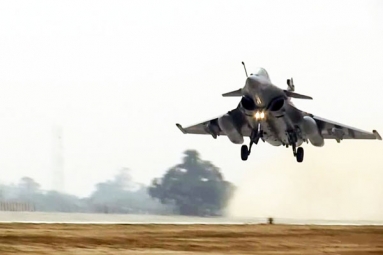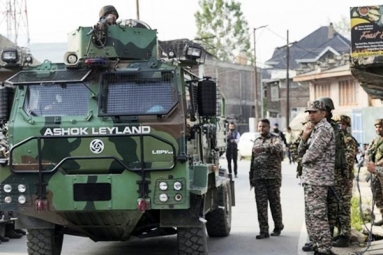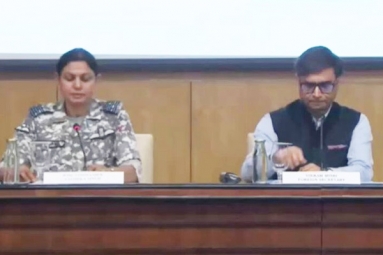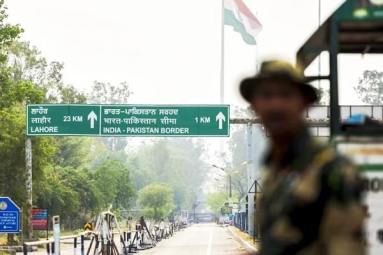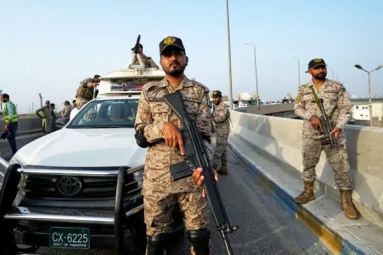
(Image source from: Twitter.com/ANI)
In a display of remarkable courage and bravery, the armed forces defended numerous cities situated in the border states of India amid the recent altercation with Pakistan. This conflict included drone assaults and various air strikes that were effectively intercepted and neutralized before they could harm civilian facilities. The Indian Army's air defense systems were crucial in countering Pakistan's aggressive maneuvers. On Monday, the Army held a demonstration showcasing how these air defense systems, such as the AKASH missile system and L-70 Air Defense Guns, protected the Golden Temple in Amritsar as well as several cities in Punjab from missile and drone attacks originating from Pakistan. Major General Kartik C Seshadri, the General Officer Commanding of the 15 Infantry Division, noted that the Indian military had foreseen Pakistan's intentions to target both military sites and civilian infrastructures, including sacred sites like the Golden Temple, which intelligence suggested was a primary target.
Major General Seshadri stated, "Recognizing that the Pakistani Army lacks legitimate targets, we predicted they would aim for Indian military sites and civilian places of significance, particularly religious institutions. The Golden Temple stood out as a key target. We deployed extra advanced air defense resources to provide comprehensive protection to the Golden Temple." He detailed that Pakistan attempted an aerial attack using drones and long-range missiles against the Golden Temple, but the army's personnel were ready to confront such threats. "On the morning of May 8, in the early hours, Pakistan launched a significant aerial offensive utilizing unmanned aerial vehicles, mainly drones and long-range missiles. We were thoroughly prepared, having anticipated this move. Our brave and vigilant army air defense gunners successfully countered the Pakistan Army's malicious plans, bringing down all the drones and missiles aimed at the Golden Temple, thereby ensuring that our sacred Golden Temple remained unscathed," Major General Seshadri stated.
#WATCH | Amritsar, Punjab: Major General Kartik C Seshadri, GOC, 15 Infantry Division says "...Consequent to Pak Army sponsored dastardly terrorist attack on innocent tourists both domestic and international, nation's anger under able leadership took the form of Operation Sindoor… https://t.co/y9gECbSao1 pic.twitter.com/sqInnRRK4M
— ANI (@ANI) May 19, 2025
The General Officer Commanding of the 15 Infantry Division elaborated on the impact of the Pahalgam terror attack, which triggered Operation Sindoor. This operation involved targeted strikes on nine terror camps deep within Pakistani territory, leading to increased hostility from the Pakistani forces. "In response to the cowardly terrorist attack, sponsored by the Pakistani Army, on innocent tourists, both domestic and foreign, the nation responded with Operation Sindoor under capable leadership, executing significant punitive strikes on designated terror targets. Out of nine identified targets, seven were successfully destroyed by the Indian Army," Major General Seshadri informed ANI.
He further emphasized that the armed forces executed strikes with "complete precision" during Operation Sindoor, hitting regions like Muridke and Bahawalpur, known to host terrorist organization headquarters. "Among these nine targets, Muridke, located near Lahore, is the base for Lashkar-e-Tayyaba, while Bahawalpur is the location of the Jaish-e-Mohammed headquarters. Both were struck with exact precision. Following the strikes, we released a statement clarifying that we deliberately refrained from targeting any military or civilian infrastructure within Pakistan," he added.
India's air defense mechanisms demonstrated their capabilities during peak tensions with its neighboring country, successfully intercepting a variety of threats, including drones, missiles, micro UAVs, and loitering munitions. This development has positioned them as a defense asset of significant global relevance.









